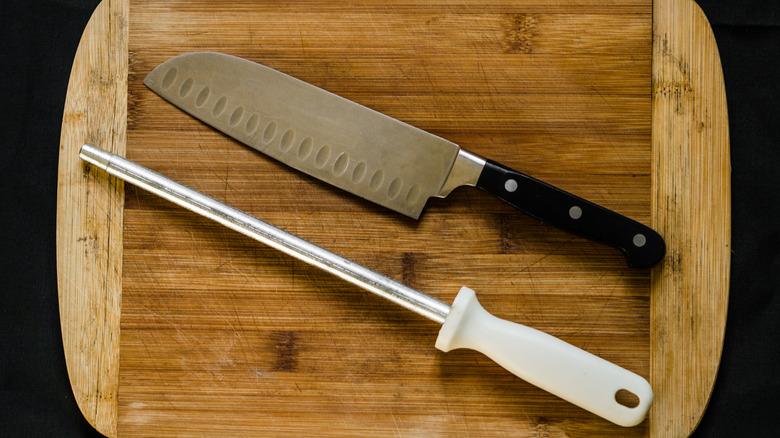Sharpen Your Knife Like A Chef With A Honing Rod
It's time to dust off that strange metal tool that's tucked into the center of your knife block. If this contraption is unfamiliar to you, it's called a honing rod, and it's not too hard to use. In fact, making a habit of honing your kitchen knives is not only easy, it's also a wise safety move. Cutting with dull blades is more dangerous than using sharp ones, since you have to use more pressure to make cuts, and that causes more risk of the blade slipping and cutting something other than its target. The keys to using this tool are angle and symmetry, and doing it regularly.
With your non-dominant hand, hold your honing rod perpendicular to a cutting board, keeping the tip of your rod firmly on the board. Holding the knife in your dominant hand, place the base of the blade at about a 20-degree angle against the rod. To help you get the correct angle, place the blade at a 90-degree angle against the rod near its handle. Then tilt the blade to roughly half that angle for a 45-degree angle. Halve that again, and you're at around 20 degrees. Draw the blade down the rod from the handle to the tip of the knife in a cutting motion. Use consistent and light pressure, and do the same on the other side of the blade. Repeat the process three to four times on each side of the blade. You can use this process for both a straight-edged and a serrated knife for the cleanest cut every time.
A few things to keep in mind
Technically, sharpening and honing are different things. Honing straightens out the cutting edge of a blade, whereas sharpening removes metal for a keener edge. In short, both honing and sharpening leave you with a better-cutting blade. However, honing keeps blades in good shape and lengthens the amount of time between sharpenings. Most importantly, both processes will ensure a long life for your knife. While you only need to sharpen your blades a few times a year, honing them weekly is wise.
If you don't already have one, there are three kinds of honing rods available: honing steels, ceramic rods, and diamond-coated sharpening steels. The Kitchen Knife Guru recommends purchasing a rod that's a few inches longer than the longest knife you'll be honing. If your blade needs a touch-up, and you don't have a rod on hand, you can also sub a coffee cup or some aluminum foil for a honing rod.
Once you've gone through the honing process, test the blade on a piece of paper. Hold the paper in front of you and draw the blade from the top of the paper down. If the paper bends with the knife's pressure or doesn't cut cleanly, it's probably time for a thorough sharpening.
